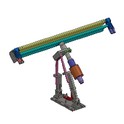Hey there! As a supplier of 2000w ultrasonic generators, I often get asked if our 2000w ultrasonic generator can be used for textile processing. Well, let's dive right into this topic and find out.
First off, let me give you a bit of background on ultrasonic generators. Ultrasonic generators are devices that convert electrical energy into high - frequency electrical signals, which are then used to drive ultrasonic transducers. These transducers convert the electrical signals into mechanical vibrations at ultrasonic frequencies. In textile processing, these vibrations can be incredibly useful.


One of the main applications of ultrasonic technology in textile processing is in the area of textile cleaning. Traditional textile cleaning methods often involve the use of large amounts of water, chemicals, and energy. With a 2000w ultrasonic generator, things can be different. The high - frequency vibrations created by the generator can cause cavitation in the cleaning solution. Cavitation is the formation and collapse of tiny bubbles in the liquid. When these bubbles collapse near the surface of the textile, they generate a powerful shockwave that can dislodge dirt, grease, and other contaminants from the fabric fibers. This means that you can achieve a more thorough cleaning with less water and fewer chemicals. It's not only more environmentally friendly but also cost - effective in the long run.
Another area where a 2000w ultrasonic generator shines in textile processing is in dyeing. In traditional dyeing processes, it can be challenging to ensure that the dye is evenly distributed throughout the fabric. The ultrasonic vibrations from the 2000w generator can help to improve the diffusion of the dye into the textile fibers. The vibrations create micro - channels in the fabric, allowing the dye to penetrate more easily and uniformly. This results in a more consistent coloration of the textile, reducing the chances of color streaks or uneven dyeing. And since the dye can penetrate better, you may even be able to use less dye, which again is a win for both cost and the environment.
When it comes to textile bonding, a 2000w ultrasonic generator can also play a crucial role. Ultrasonic bonding is a process where two or more layers of textile are joined together using ultrasonic energy. The 2000w of power provides enough energy to generate strong bonds between the fabric layers. The high - frequency vibrations cause the molecules in the textile materials to rub against each other, generating heat through friction. This heat melts the fibers at the bonding points, creating a strong and durable bond. Compared to traditional bonding methods like sewing or using adhesives, ultrasonic bonding is faster, more efficient, and can result in a cleaner finish.
Now, you might be wondering how the 2000w power level compares to other options. Well, we also offer a 1000W Ultrasonic Generator and a 6000W Ultrasonic Generator. The 1000w generator is suitable for smaller - scale textile processing operations or when you need a more delicate touch. For example, if you're working with very thin or delicate fabrics, the 1000w generator can provide just the right amount of energy without causing damage to the fabric. On the other hand, the 6000w generator is designed for large - scale industrial applications where you need a high - power output to handle a large volume of textiles quickly. The 2000w generator strikes a good balance. It has enough power to handle most medium - to large - scale textile processing tasks, whether it's cleaning, dyeing, or bonding, but it's not so overpowering that it will damage the fabrics.
Of course, like any technology, there are some considerations when using a 2000w ultrasonic generator for textile processing. You need to make sure that the generator is properly matched with the ultrasonic transducer. The transducer is the part that actually converts the electrical energy into mechanical vibrations, and a good match between the generator and the transducer is essential for optimal performance. Also, you need to choose the right frequency for your specific textile processing task. Different frequencies can have different effects on the fabric and the processing results. For example, lower frequencies are better for cleaning, while higher frequencies may be more suitable for bonding.
In addition, the design of the ultrasonic processing equipment is also important. You need to ensure that the equipment is designed to handle the 2000w power output safely and efficiently. This includes proper cooling systems to prevent overheating of the generator and the transducer, as well as a stable power supply to ensure consistent performance.
So, to answer the question, yes, a 2000w ultrasonic generator can definitely be used for textile processing. It offers a range of benefits in cleaning, dyeing, and bonding, and it's a great option for medium - to large - scale textile processing operations. If you're in the textile processing industry and looking for a reliable and efficient way to improve your processes, I highly recommend considering our 2000W Ultrasonic Generator.
If you're interested in learning more about our 2000w ultrasonic generator or want to discuss your specific textile processing needs, don't hesitate to reach out. We're always happy to have a chat and help you find the best solution for your business.
References
- "Ultrasonic Technology in Textile Processing" - Journal of Textile Science and Engineering
- "Cavitation and Its Applications in Textile Cleaning" - International Journal of Textile Research
- "Advances in Ultrasonic Dyeing of Textiles" - Textile Chemistry and Coloration Journal






